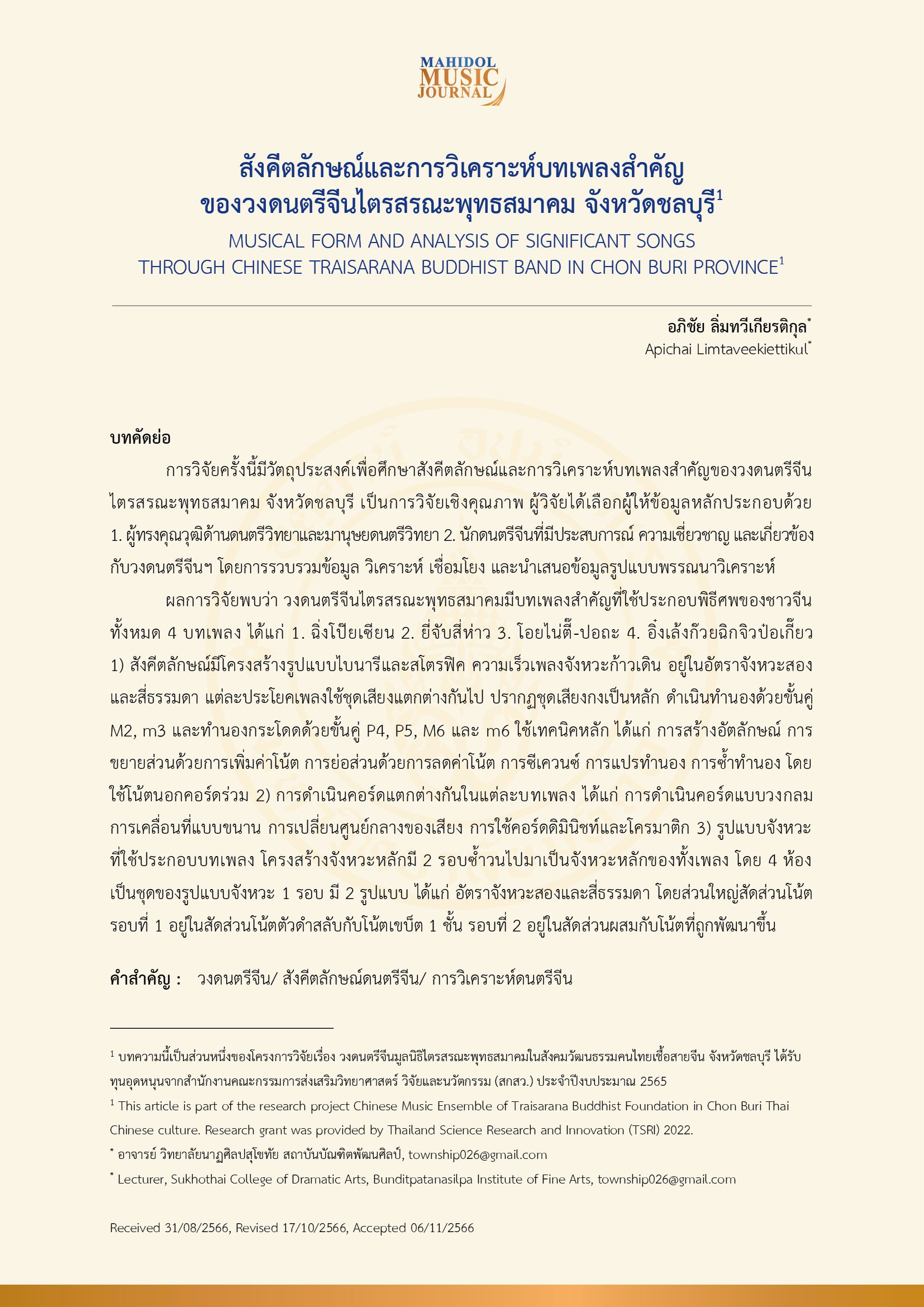MUSICAL FORM AND ANALYSIS OF SIGNIFICANT SONGS THROUGH CHINESE TRAISARANA BUDDHIST BAND IN CHON BURI PROVINCE
Keywords:
Chinese Music Ensemble, Chinese Traditional Music Form, Chinese Music AnalysisAbstract
The objective of this research is to study the Musical Form and Analysis of Significant Songs through Chinese Traisarana Buddhist Band in Chon Buri Province. This is the qualitative research; a researcher has chosen two essential informants: experts of musicology and ethnomusicology, and Chinese musicians who have experiences, expertise, and relationship with the Chinese Music Ensemble. The researcher has collected information, connection, and presentation in a descriptive analysis.
The results find that the Chinese Traisarana Buddhist Band has chosen four important songs for performing in Chinese funerals: Qing Poi Sian, Er Shi Si Xiao, Oi Nai Ti - Po Tha, and Ing Leng Kuai Chi Chio Po Kiao. Firstly, the forms are binary form and strophic form. The speed is andante in the simple time signature. Each phrase applies different sets of sounds, and its main set is Kung. The conjunct progression is conducted by the interval M2, and m3 while the disjunct progression is conducted by the internal P4, P5, M6, and m6. Progression applies main techniques consisting of characteristics of sounds, augmentation, diminution, sequence, variation, and repetition which also use non-chord tones. Secondly, the chord progression is different from each song, consisting of a circle chords progression, a parallel harmonic movement, modulation, diminished chord, and chromatic. Thirdly, the main structure of a rhythmic pattern has two repetitive rounds, which become the core rhythm of the whole song. The rhythmic pattern of each four bars consists of one round. Each round has two forms: simple duple meter, and simple quadruple meter. Most of the first round will be composed of quarter notes alternating between the eighth note while the second round will be composed of quarter notes merged with the developed notes.
References
Barton, Jintana. “A Comparative Study of Chinese Musical Activities in Chinese and Thai Cultural Contexts.” MANUSYA: Journal of Humanities 10, no. 2 (2007): 1-14.
Duan, Lisheng. Thai History in Chinese Aspect. Bangkok: Phirap, 1997. (in Thai)
Haydon, Glen. Introduction to Musicology: A Survey of the Fields, Systematic and Historical, of Musical Knowledge and Research. New York: Prentice-Hall, 1946.
Helmholtz, Hermann. On the Sensations of Tone as a Physiological Basis for the Theory of Music. Austin: Cambridge: Cambridge University Press, 2009.
Huang, Hsun-Pin. “Theory and Practice in the Traditional Chinese music: Observations and Analysis.” PhD diss., The Graduate Council of the University of North Texas, 1994.
May, Elizabeth. Music of Many Cultures: An Introduction. Berkeley: University of California Press, 1980.
Merriam, Alan Parkhurst. The Anthropology of Music. Chicago: Northwestern University Press, 1964.
Mugglestone, Erica, and Guido Adler. “Guido Adler's ‘The Scope, Method, and Aim of Musicology’ (1885): An English Translation with an Historico-Analytical Commentary.” Yearbook for Traditional Music 13, (1981): 1-21.
Nettl, Bruno. “The Western Impact on World music. Change, Adaptation, and Survival.” Yearbook for Traditional Music 19, (1987): 117-120.
Pancharoen, Natchar. Form and Analysis. Bangkok: Chula Book Center, 2017. (in Thai)
Pidokrajt, Narongchai. “Ethnomusicology.” Parichart Journal 8, no. 1 (April-September 1994): 5-11. (in Thai)
Premananda, Weerachat. Philosophy and Techniques of Song Composition of Thai contemporary song. Bangkok: Chulalongkorn University, 1994. (in Thai)
Schneider, Albrecht. “Comparative and Systematic Musicology in Relation to Ethnomusicology: A Historical and Methodological Survey.” Ethnomusicology 50, no. 2 (Spring/Summer 2006): 236-258.
Shi, Jiazi. “East Meets West: A Musical Analysis of Chinese Sights and Sounds, by Yuankai Bao.” PhD diss., Louisiana State University and Agricultural and Mechanical College, 2016.
Skinner, George William. Chinese Society in Thailand: An Analytical History. New York: Cornell University, 1962.
Trakulhun, Wiboon. Western Music Theory. Bangkok: Chulalongkorn University Printing House, 2021. (in Thai)
Watson, James Lopez. “The Structure of Chinese Funerary Rites: Elementary Forms, Ritual Sequence, and the Primacy of Performance.” In Death Ritual in Late Imperial and Modern China, Edited by James L. Watson and Evelyn S. Rawski, 3-19. Berkeley and Los Angeles: University of California Press, 1988.
Williams, Paul, and Patrice Ladwig. Buddhist Funeral Cultures of Southeast Asia and China. New York: Cambridge University Press, 2012.

Downloads
Published
How to Cite
Issue
Section
License
Copyright (c) 2024 College of Music

This work is licensed under a Creative Commons Attribution-NonCommercial-NoDerivatives 4.0 International License.
The copyright of the article belongs to the author. Published articles represent the views of the authors. The editorial team neither necessarily agree with nor take any responsibility for the article.





